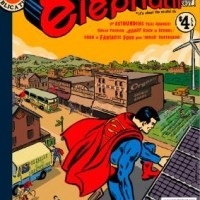Hotelephant: our editor’s home by night and elephant’s H.Q. by day (when we’re not tapping away at wireless cafés). Bought with $0 down, our goal is to (not default on the mortgage and) greenovate: to effect every single little detail of our renovation responsibly, affordably and elegantly. Fifth in a series on the greening of Hotelephant, this piece-by elephriend and Mr. Eco Handyman himself, Nate Burger, expands on his recent eco-insulation of our drafty attic and shares the first, best steps toward the greening of your own home. -ed.
1. Come wintertime, mothers want their children to wear a shell to protect from the elements and fleece to insulate from freezing outside temperatures. Your home is no different: siding protects it from weather, and insulation prevents warm inside air from escaping through the walls.
Older houses are typically drafty, making them more expensive to heat and cool. A home energy audit can determine the source of any leaks and suggest ways to correct them (a technician will use a “blower door” to suck air out your front door and pinpoint unseen gaps and penetrations-see iamelephant.com for last issue’s article). A home energy audit also evaluates insulation, combustion appliances, window efficiency, hot water pipes, the furnace and air conditioning. The technician will then be able to recommend ways to improve your home’s energy efficiency. If you get a home energy audit, make sure the technician is certified through the “Home Performance with Energy Star®” program.
2. Caulk leaks around doors and windows. Then check ductwork in your crawl space to make sure the supply side is insulated, which will keep the air warm until it reaches its destination-and seal any gaps spilling out air.
3. Attic insulation is the best way to reduce your winter heating bill-and to keep your house cooler in summer. Blown-in cellulose-made from recycled newspapers treated with a fire retardant-is eco-benign and affordably installed by professionals in a single day. Because of gaps between rolls, fiberglass insulation-the pink insulation common in most homes-doesn’t block air as well as blown-in cellulose. If you can afford it, blown foam is the “Cadillac” of insulation-the most energy-efficient choice on the market. It seals and insulates.
4. Get a programmable thermostat, and you’ll improve a home’s comfort level (warm when you wake up) while reducing your energy bill. It allows you to program the home’s temperature for times of the day and even accounts for weekends. In winter, program the house to be cooler when you go to bed, heat up before you rise, cool when you’re at work, and warm before you return home. You won’t notice the temperature fluctuations-but you will notice more cash in your (englishretreads.com recycled tire) wallet.
5. You know about compact fluorescent lightbulbs, but I bet you still use a few old-school incandescent bulbs. CFLs use one-third the energy of incandescent bulbs, and last 10 times longer. That’s a huge boon-energy-wise, dollar-wise and trash-wise. Instead of telling yourself, “I’ll replace my regular bulbs when they burn out,” consider that each CFL in your home saves well over $75 over its life span. And many now give off a warmer light.
6. Single-pane aluminum windows conduct heat and cold rather than insulate. It’s expensive, but worth it long term to replace them now with double-pane windows. Choose a brand with a low-emissivity coating.
7. Schedule a yearly maintenance call to ensure your heating and cooling systems are burning efficiently and not producing high levels of carbon monoxide. Regularly replace your furnace filter with a high-efficiency filter.
8. An older furnace is 70 to 80 percent efficient. Replacing it with a 90 percent efficient furnace (a S.E.E.R. rating of 13 or higher) saves energy. And unlike older models, efficient furnaces seal combustion, virtually eliminating carbon monoxide buildup.
9. You’re paying to heat your highest reaches. Use a ceiling fan to circulate warm air back down where you live. Reverse the spin to keep cool in the summer.
10. Cover your hot water tank with a big “blanket” (ask for one at an independent hardware store). While you’re at it, turn down the hot water temperature gauge-you’ll save energy and still get sufficient hot water for showers and baths. Insulating hot water pipes that run through unheated spaces will keep water hot-and you won’t have to run the faucet, waiting for hot water.
11. Upgrade to Energy Star refrigerators and washing machines. You’ll save money: heating water in a washing machine accounts for 85 percent of the energy use per load of laundry. Energy Star front-loading washers use one-third the water, saving money on energy and water bills. Additionally, the spin cycle rotates nearly twice as fast-that means drier clothes and half the drying time. And front-loaders are gentler on clothes, so your favorite tee and jeans will last longer. These machines pay for themselves in a few years-or less if you have a large family.
Scratch these energy-efficient ideas off your to-do list and you’ll do your wallet, home and your grandchildren a favor.
Via Nate Burger, from elephant journal’s Winter 07/08 issue.
Nate Burger is the founder of Eco Handyman and a Boulder Green Building Guild board member. We recommend him.






Read 13 comments and reply